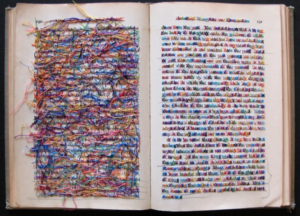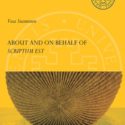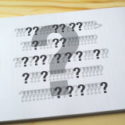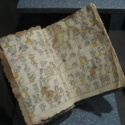
The word text and the word textile have a shared Latin origin. This is readily apparent, but still it begs the question: What do texts have to do with textiles?
The word text comes to us from the Latin textus (via the Old French texte). In Classical Latin, textus referred to the construction of a linguistic work; in Medieval Latin, it had come to refer to written treatises or, more specifically, Scripture. The term textus, in turn, came from the word texō, meaning “I weave.” Textile, then, refers to a literal weaving of cloth and other materials, whereas text refers to a metaphorical weaving. Also related is the word texture, which refers to the quality of a weaving—I can talk about the texture of an argument or the texture of a tapestry.
But a text is never really just a metaphorical weaving. It is, always, also, a literal weaving of material and idea. We don’t always seem to appreciate this. For instance, we likely consider two different copies of a book to have the same text, even if they are different editions. However, a text must be written—otherwise it would just be a series of words or an idea. Therefore, the writtenness of a text must have something to do with its meaning.
This was the insight behind the Texts and Textiles conference in 2012 at the Centre for Material Texts at Cambridge. (Wish I could have gone!) This conference celebrates the meaning that materials contribute to texts (as, I must meantion, does the Document Academy on an ongoing basis, for those who are interested).
Still, our tendency to ignore the material side of texts is unignorable and worth exploring.
I’m not sure the extent to which this aspect of our view of texts is modern or new, but if it is, then the work of Michael Heim may shed some insight on the matter. In his book Electric Language: A Philosophical Study of Word Processing, first published in 1987, Heim writes:
In the psychic framework of word processing, text is increasingly experienced as data. … As the writer or reader now controls the search process through a logically determined program, certain random and intuitive kinds of reading and consulting will no longer be possible in referencing procedures. … What one accesses on line will tend to be precisely what one is looking for—always filtered in advance by the terms of Boolean logic.
Ron Day, in his book Indexing It All, makes similar observations: He discusses how the concept of document has been eviscerated and fragmented as the modern concept of information.
In essence, the motto of information systems seems to go: “If you want to be more successful in giving people what they ask for, then limit what they can ask for.” Soon people come to ask for only what they know they can get… and this provides the grounding for two big information-age issues we’re facing today: filter bubbles and fake news. Overcoming these phenomena, it seems to me, requires that we remember how to feel the texture of text.
 Follow
Follow

